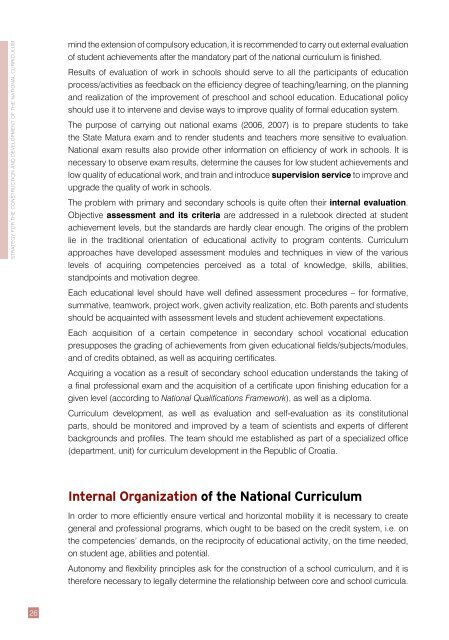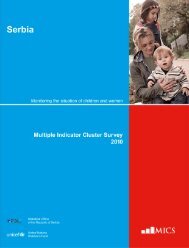NATIONAL CURRICULUM
NATIONAL CURRICULUM
NATIONAL CURRICULUM
- No tags were found...
You also want an ePaper? Increase the reach of your titles
YUMPU automatically turns print PDFs into web optimized ePapers that Google loves.
STRATEGY FOR THE CONSTRUCTION AND DEVELOPMENT OF THE <strong>NATIONAL</strong> <strong>CURRICULUM</strong>mind the extension of compulsory education, it is recommended to carry out external evaluationof student achievements after the mandatory part of the national curriculum is finished.Results of evaluation of work in schools should serve to all the participants of educationprocess/activities as feedback on the efficiency degree of teaching/learning, on the planningand realization of the improvement of preschool and school education. Educational policyshould use it to intervene and devise ways to improve quality of formal education system.The purpose of carrying out national exams (2006, 2007) is to prepare students to takethe State Matura exam and to render students and teachers more sensitive to evaluation.National exam results also provide other information on efficiency of work in schools. It isnecessary to observe exam results, determine the causes for low student achievements andlow quality of educational work, and train and introduce supervision service to improve andupgrade the quality of work in schools.The problem with primary and secondary schools is quite often their internal evaluation.Objective assessment and its criteria are addressed in a rulebook directed at studentachievement levels, but the standards are hardly clear enough. The origins of the problemlie in the traditional orientation of educational activity to program contents. Curriculumapproaches have developed assessment modules and techniques in view of the variouslevels of acquiring competencies perceived as a total of knowledge, skills, abilities,standpoints and motivation degree.Each educational level should have well defined assessment procedures ‡ for formative,summative, teamwork, project work, given activity realization, etc. Both parents and studentsshould be acquainted with assessment levels and student achievement expectations.Each acquisition of a certain competence in secondary school vocational educationpresupposes the grading of achievements from given educational fields/subjects/modules,and of credits obtained, as well as acquiring certificates.Acquiring a vocation as a result of secondary school education understands the taking ofa final professional exam and the acquisition of a certificate upon finishing education for agiven level (according to National Qualifications Framework), as well as a diploma.Curriculum development, as well as evaluation and self-evaluation as its constitutionalparts, should be monitored and improved by a team of scientists and experts of differentbackgrounds and profiles. The team should me established as part of a specialized office(department, unit) for curriculum development in the Republic of Croatia.Internal Organization of the National CurriculumIn order to more efficiently ensure vertical and horizontal mobility it is necessary to creategeneral and professional programs, which ought to be based on the credit system, i.e. onthe competencies’ demands, on the reciprocity of educational activity, on the time needed,on student age, abilities and potential.Autonomy and flexibility principles ask for the construction of a school curriculum, and it istherefore necessary to legally determine the relationship between core and school curricula.26

















